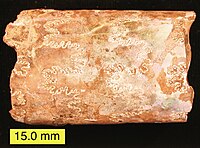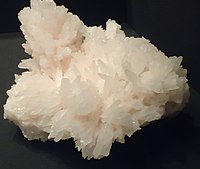| Revision as of 14:05, 11 April 2014 editGilliam (talk | contribs)Administrators497,031 editsm Reverted edits by 111.68.103.4 (talk) to last version by ClueBot NG← Previous edit | Revision as of 12:01, 17 June 2014 edit undo110.175.57.184 (talk) →OccurrenceNext edit → | ||
| Line 46: | Line 46: | ||
| The ] for aragonite is ] (], ]), 25 km from ] for which it was named in 1797.<ref name=Mindat/> An aragonite cave, the ], is situated in ]. In the USA, aragonite in the form of ]s and "cave flowers" (]) is known from ] and other caves. Massive deposits of ] are found on the seabed in the ]. | The ] for aragonite is ] (], ]), 25 km from ] for which it was named in 1797.<ref name=Mindat/> An aragonite cave, the ], is situated in ]. In the USA, aragonite in the form of ]s and "cave flowers" (]) is known from ] and other caves. Massive deposits of ] are found on the seabed in the ]. | ||
| Aragonite forms naturally in almost all ] shells, and as the calcareous endoskeleton of warm- and cold-water ]s (]). Several ] have aragonitic tubes. Because the mineral deposition in mollusk shells is strongly biologically controlled, some crystal forms are distinctively different from those of inorganic aragonite. In some mollusks, the entire shell is aragonite; in others, aragonite forms only discrete parts of a bimineralic shell (aragonite plus calcite). Aragonite also forms in the ocean and in caves as inorganic precipitates called marine cements and ]s, respectively. The nacreous layer of the aragonite ] shells of some extinct ]s forms an ] material called ]. Ammolite is primarily aragonite with impurities that make it ] |
Aragonite forms naturally in almost all ] shells, and as the calcareous endoskeleton of warm- and cold-water ]s (]). Several ] have aragonitic tubes. Because the mineral deposition in mollusk shells is strongly biologically controlled, some crystal forms are distinctively different from those of inorganic aragonite. In some mollusks, the entire shell is aragonite; in others, aragonite forms only discrete parts of a bimineralic shell (aragonite plus calcite). Aragonite also forms in the ocean and in caves as inorganic precipitates called marine cements and ]s, respectively. The nacreous layer of the aragonite ] shells of some extinct ]s forms an ] material called ]. Ammolite is primarily aragonite with impurities that make it ] and valuable as a ]. | ||
| Aragonite is metastable and is thus commonly replaced by calcite in fossils. Aragonite older than the ] is essentially unknown.<ref>{{cite doi|10.1080/03115518508618971}}</ref> | Aragonite is metastable and is thus commonly replaced by calcite in fossils. Aragonite older than the ] is essentially unknown.<ref>{{cite doi|10.1080/03115518508618971}}</ref> | ||
Revision as of 12:01, 17 June 2014
| Aragonite | |
|---|---|
 Aragonite from Salsignes Mine, Aude department, France Size: 30x30x20 cm Aragonite from Salsignes Mine, Aude department, France Size: 30x30x20 cm | |
| General | |
| Category | Carbonate mineral |
| Formula (repeating unit) | CaCO3 |
| Strunz classification | 05.AB.15 |
| Crystal system | Orthorhombic |
| Space group | Orthorhombic (2/m 2/m 2/m) - dipyramidal |
| Unit cell | a = 4.95 Å, b = 7.96 Å, c = 5.74 Å; Z = 4 |
| Identification | |
| Color | White, red, yellow, orange, green, purple, grey, blue and brown |
| Crystal habit | Pseudohexagonal, prismatic crystals, acicular, columnar, globular, reniform, pisolitic, coralloidal, stalactitic, internally banded |
| Twinning | Polysynthetic parallel to {100} cyclically on {110} |
| Cleavage | Distinct on {010}, imperfect {110} and {011} |
| Fracture | Subconchoidal |
| Tenacity | Brittle |
| Mohs scale hardness | 3.5-4 |
| Luster | Vitreous, resinous on fracture surfaces |
| Streak | White |
| Diaphaneity | Translucent to transparent |
| Specific gravity | 2.95 |
| Optical properties | Biaxial (-) |
| Refractive index | nα = 1.529 - 1.530 nβ = 1.680 - 1.682 nγ = 1.685 - 1.686 |
| Birefringence | δ = 0.156 |
| 2V angle | 18° |
| Solubility | Dilute acid |
| Other characteristics | Fluorescence: pale rose, yellow, white or bluish; phosphorescence: greenish or white (LW UV); yellowish (SW UV) |
| References | |
Aragonite is a carbonate mineral, one of the two common, naturally occurring, crystal forms of calcium carbonate, CaCO3 (the other form being the mineral calcite). It is formed by biological and physical processes, including precipitation from marine and freshwater environments.
Aragonite's crystal lattice differs from that of calcite, resulting in a different crystal shape, an orthorhombic system with acicular crystals. Repeated twinning results in pseudo-hexagonal forms. Aragonite may be columnar or fibrous, occasionally in branching stalactitic forms called flos-ferri ("flowers of iron") from their association with the ores at the Carinthian iron mines.
Occurrence
The type location for aragonite is Molina de Aragón (Guadalajara, Spain), 25 km from Aragon for which it was named in 1797. An aragonite cave, the Ochtinská Aragonite Cave, is situated in Slovakia. In the USA, aragonite in the form of stalactites and "cave flowers" (anthodite) is known from Carlsbad Caverns and other caves. Massive deposits of oolitic aragonite sand are found on the seabed in the Bahamas.
Aragonite forms naturally in almost all mollusk shells, and as the calcareous endoskeleton of warm- and cold-water corals (Scleractinia). Several serpulids have aragonitic tubes. Because the mineral deposition in mollusk shells is strongly biologically controlled, some crystal forms are distinctively different from those of inorganic aragonite. In some mollusks, the entire shell is aragonite; in others, aragonite forms only discrete parts of a bimineralic shell (aragonite plus calcite). Aragonite also forms in the ocean and in caves as inorganic precipitates called marine cements and speleothems, respectively. The nacreous layer of the aragonite fossil shells of some extinct ammonites forms an iridescent material called ammolite. Ammolite is primarily aragonite with impurities that make it iridescent and valuable as a gemstone.
Aragonite is metastable and is thus commonly replaced by calcite in fossils. Aragonite older than the Carboniferous is essentially unknown.
Physical properties
Aragonite is thermodynamically unstable at standard temperature and pressure, and tends to alter to calcite on scales of 10 to 10 years. The mineral vaterite, also known as μ-CaCO3, is another phase of calcium carbonate that is metastable at ambient conditions typical of Earth's surface, and decomposes even more readily than aragonite.
Uses
In aquaria, aragonite is considered essential for the replication of reef conditions in aquariums. It not only is the material that the sea life is evolved to use and live around, but also keeps the tank's pH close to its natural level.
Gallery
-
 Aragonite crystals from Cuenca, Castile-La Mancha, Spain
Aragonite crystals from Cuenca, Castile-La Mancha, Spain
-
 Cluster of twinned aragonite from Morocco
Cluster of twinned aragonite from Morocco
-
 Remnant biogenic aragonite (thin, rainbow-colored shell) on the ammonite Baculites (Pierre Shale, Late Cretaceous, South Dakota).
Remnant biogenic aragonite (thin, rainbow-colored shell) on the ammonite Baculites (Pierre Shale, Late Cretaceous, South Dakota).
-
 Scanning electron microscope image of aragonite layers in the nacre of a blue mussel (Mytilus edulis).
Scanning electron microscope image of aragonite layers in the nacre of a blue mussel (Mytilus edulis).
-
 Pink Aragonite Crystals
Pink Aragonite Crystals
-
 Fluorescence of Aragonite
Fluorescence of Aragonite
See also
- Aragonite sea
- Ikaite, CaCO3·6H2O
- Monohydrocalcite, CaCO3·H2O
- Nacre, otherwise known as "Mother-of-Pearl"
- Oolitic aragonite sand
References
- ^ Mindat.org
- Handbook of Mineralogy
- Webmineral data
- Attention: This template ({{cite doi}}) is deprecated. To cite the publication identified by doi:10.1080/03115518508618971, please use {{cite journal}} (if it was published in a bona fide academic journal, otherwise {{cite report}} with
|doi=10.1080/03115518508618971instead.